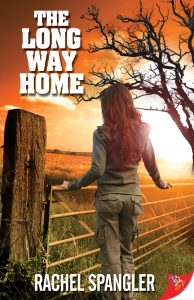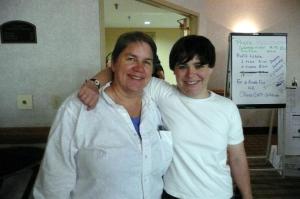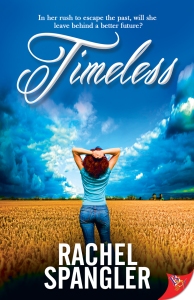First of all, let’s kick things off with a book giveaway. Last week, in honor of my father-in-law, I asked you all to leave a comment mentioning a person who left a legacy of love and joy in your own life, and I got some great responses. So I randomized them and picked a winner. Melinda won a free, signed copy of Close To Home or an ebook of any of my other novels. Melinda, please shoot me a quick email (Rachel_Spangler@yahoo.com) with your details.
Now, on with the show. When I did my survey a few weeks ago, 80% of you said the types of blogs you most want to read here are ones that feature “the stories behind the stories,” so that’s what I plan to do here, and I want to start with Kelly.
Kelly has probably had the biggest evolution of any character I’ve ever written (though Nic from Does She Love You? would win a lot of votes in that category, too). Kelly has quite an arc from the first time I ever met her in the opening chapters of The Long Way Home. This is hard to do without spoilers, but as I started writing her, I couldn’t stand her. I’m not sure why I didn’t like her. Maybe I felt like I needed a villain in this story. Or maybe I was mad at people like her, people who conformed and hid and fed into the small-town status quo when people like me (Or should it be “people like Raine”?) were out there fighting an uphill battle everyday. Then in one of those chicken-or-egg type of artist tussles, I made her look like, and to a certain extent sound like, someone I hadn’t gotten along with in high school. I’m still not sure if I wrote a villain and made her similar to my high school foe, or if I wrote someone like my high school foe and turned her into a villian.
 Through much of the first draft of The Long Way Home, Kelly was irredeemable. I poured on her all of my residual frustration at everyone who ever followed the rules at the expense of another human being. I made her sharp and unreasonable, and most of all, one dimensional. Then came a scene in which she’s lost. She sees something she always knew would happen come to fruition, and she’s hurt and angry, but she still does what’s right, at least in her own mind. I never intended it, but she, in her own way, became the one person who could hold up the mirror to our protagonist. It was just one scene, one little shift, and honestly she didn’t change much in that moment so much as the moment revealed part of her I hadn’t understood before. She was no longer the person who just said mean things. She was a person who asked hard questions.
Through much of the first draft of The Long Way Home, Kelly was irredeemable. I poured on her all of my residual frustration at everyone who ever followed the rules at the expense of another human being. I made her sharp and unreasonable, and most of all, one dimensional. Then came a scene in which she’s lost. She sees something she always knew would happen come to fruition, and she’s hurt and angry, but she still does what’s right, at least in her own mind. I never intended it, but she, in her own way, became the one person who could hold up the mirror to our protagonist. It was just one scene, one little shift, and honestly she didn’t change much in that moment so much as the moment revealed part of her I hadn’t understood before. She was no longer the person who just said mean things. She was a person who asked hard questions.
Then the unthinkable happened. My beta readers felt sorry for her, because my beta readers are good people who saw a humanity in her I wasn’t willing to admit to yet. Then my editor cut two scenes Kelly had been a big part of and asked me to incorporate the aspects of her that had been cut into other scenes. I had to go back and take a look at Kelly as I’d initially written her, but with new understanding of her as important, as sympathetic, as human. I realized that in a story where Raine/Rory has to overcome her childish understanding of her hometown and the people in it, I as a writer had failed to do the same. Kelly’s actions remained the same. Outwardly she was the same person I’d butted heads with in high school, but inwardly, and occasionally when she was alone with Beth, a tenderness had been revealed just enough to leave me wondering about who she really was, and many of my readers felt the same way. Even my boss at the time, Radclyffe, wrote and said something along the lines that she liked that I’d been fair and sympathetic in my portrayals of life in the closet. I wasn’t at all sure that’s what I’d wanted to do, but it was done, and I was left feeling a little unsettled.
Then, a few months after The Long Way Home came out, I met and became friends with 
Kelly Smith of Bywater Books. Kelly Smith, or “Real Life Kelly,” as my wife started calling her, had recently published a book by my good friend Georgia Beers (Oy, this blog is getting very name-dropperish), and so we found ourselves in the same circles at literary events and we got along really well. Well enough, in fact, for Real Life Kelly to give me some honest feedback on The Long Way Home. As we walked through Provincetown one fall afternoon, she told me she’d liked the book overall, but she hated that I’d named the bitchy character “Kelly.” I laughed and said that was before I’d known her. She said she hoped that now that we were friends I would remedy the situation.
I laughed again, but Real Life Kelly turned serious and said, “I mean it. That character has the potential to have a great redemption story. She could be a complex character to unravel. There are real people out there just like her. They are human. They became how they are for a reason.” I said I’d thought a little bit about that but doubted anyone would really be able to root for someone like Fictional Kelly, especially after the things she’d said and done to Beth (who seemed to be universally loved by my readers). Real Life Kelly got a giddy glint in her eye and said, “Oh yeah, you’re going to have make her pay for that, really put her through the wringer, break her down in a big way, but it’ll be fun, and it’ll be interesting.”I admitted that putting a character that reminded me of people who had been tools in high school through the emotional wringer did sound enjoyable, but I had other books to write first. And I did.
 I wrote several more books before even considering a return to Darlington. And even when I did, Fictional Kelly didn’t factor in prominently. She does make an appearance in Timeless, though it’s a blink-and-you’d-miss-it kind of moment. However, due to the fluid timeline of the book, I actually got to picture her at the age of 20 for just a hot second. I got to imagine a flash of the beginning of something I’d gleefully ended in The Long Way Home. To see her then, little more than a girl, and still so dedicated to doing things the right way. The moment itself might have been fleeting, but it was enough to open up another little piece of my heart and mind to this woman I didn’t want to like.
I wrote several more books before even considering a return to Darlington. And even when I did, Fictional Kelly didn’t factor in prominently. She does make an appearance in Timeless, though it’s a blink-and-you’d-miss-it kind of moment. However, due to the fluid timeline of the book, I actually got to picture her at the age of 20 for just a hot second. I got to imagine a flash of the beginning of something I’d gleefully ended in The Long Way Home. To see her then, little more than a girl, and still so dedicated to doing things the right way. The moment itself might have been fleeting, but it was enough to open up another little piece of my heart and mind to this woman I didn’t want to like.
And yet I moved on to other books, but between each of them as I’d consider possibilities for my next project, my wife would say, “How about Kelly’s book?” The term “Kelly’s book” became common in our house for its double meaning, the book Real Life Kelly suggested, the book that lets the world finally see the whole picture of Fictional Kelly. But each time I had the chance to write it, something stopped me. Looking back now, I suspect I wasn’t ready to let go of my anger at her and what she represented for me. Or maybe I just wasn’t in the right place as a writer to tackle a project as complex as Fictional Kelly would be.
It wasn’t until I had been working for Bywater for a while that Real Life Kelly asked again about Fictional Kelly. I’m not sure what it was about the timing or the setting, or maybe I’d just grown weary of fighting the urge, but I agreed to at least sit down with her (Fictional Kelly, that is) and really listen. I’d like to say she just poured out her soul to me. She didn’t. She wrestled me, and she wrestled Elliot for months just like she always had. Tiny flashes of something human only occasionally peeked out from under piles and piles of frustrating anger, professional excuses, and emotional brick walls. I’m not sure Fictional Kelly had changed a whole lot, but maybe I had. As a writer, as a person, I was more willing to ask the harder questions and more willing to listen to the answers.
 That isn’t to say the process of writing Close To Home was a pretty one. I almost abandoned the story halfway through because I was still wrestling with Fictional Kelly, and despite putting her in a heart-wrenching situation, I still hadn’t fallen in love with her the way I’d fallen in love with Elliot. I told my new Bywater colleague Marianne K. Martin over lunch, once again in Provincetown (Important things happen in Ptown.), and MKM shared some of her wisdom about writing complex characters by suggesting I find one good thing in Fictional Kelly, one positive that rings true for her in all situations, even when she is behaving badly by all outward standards. As much as I hated to admit it, I knew right away what the things was.
That isn’t to say the process of writing Close To Home was a pretty one. I almost abandoned the story halfway through because I was still wrestling with Fictional Kelly, and despite putting her in a heart-wrenching situation, I still hadn’t fallen in love with her the way I’d fallen in love with Elliot. I told my new Bywater colleague Marianne K. Martin over lunch, once again in Provincetown (Important things happen in Ptown.), and MKM shared some of her wisdom about writing complex characters by suggesting I find one good thing in Fictional Kelly, one positive that rings true for her in all situations, even when she is behaving badly by all outward standards. As much as I hated to admit it, I knew right away what the things was.
Kelly does the right thing, always. Not always the nice thing, or the thoughtful thing, or the reasonable thing, but the thing she believes is right in the long run, or the big picture. She might have bad reasons or faulty logic, but she always does what she thinks is expected of her, what she would expect out of others, according to her high and often skewed personal standards.
I went home and reread what I’d written, and Marianne was right. When I focused on that driving thread, I didn’t always love Kelly, but I understood her. From there I learned to recognize the strength and conviction it had taken to make the decision she’d made, even at the same time I disagreed with them. And once I could do that, it was much easier to respect her motives while still hating the outcomes. It also made it easier to throw her in to Elliot’s path because much like I’d learned to recognize something fundamentally good in her, I also understood that someone who is focused on doing what’s right would have no choice but to see the same fundamental goodness in Elliot.
From there on out, much of my wrestling with Kelly mirrored Kelly’s own wrestling with Elliot, so much so that by the time I finished, I actually ended up liking her quite a bit, both as a character and as a metaphor for my own journey as a person and as a writer.
She’s still complex, she still grates on my nerves, she still challenges me, but somewhere over the last three books, she stopped being a product of my high school angst and became a real person, at least in the fictional sense.
At some point over the last eight years, she grew up.
Or maybe I did.
Absolutely fascinating backstory. We all have an arc; we are all evolving, hopefully into our better selves. Thank you for all of the thought and creative effort you put into redeeming this character.
Great backstory and awesome blog! Even though I’ve read all three of the novels and knew what you were talking about for the most part, “Oh, yeah I wonder if that means when…,” it made me want to go back and reread the first and last ones again with your non-spoiler assessment in mind!
What a thought-provoking account of one character’s arc! Your explanations make perfect sense, and I have had that happen in real life: acquaintances who drove me nuts became friends when I understood better why they were saying or doing things that irritated or antagonized me. Life … Great blog!
I enjoyed your recounting of the evolution of your character. It was even more interesting because I know Marianne and Real Kelly.
Fascinating, thank you. Looking forward to reading Close to Home with greater insight.